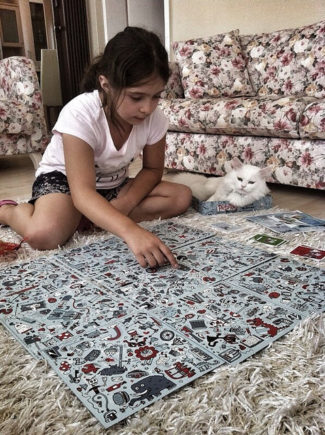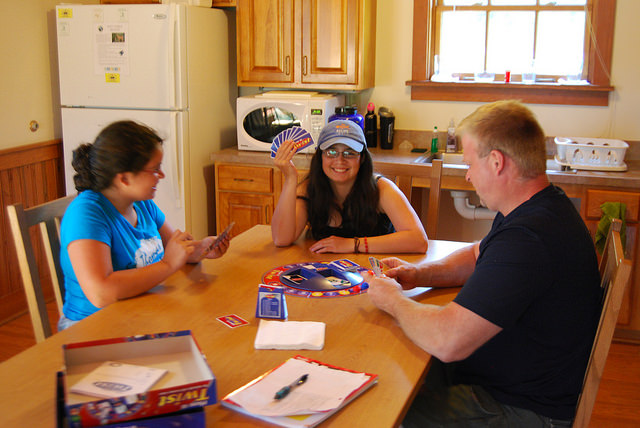Of course you know by now that we here at LearningWorks for Kids support the use of video games to improve processing speed in children. Though it seems fewer families these days play board games together, the unplugged ancestors of video games are also highly effective skill-building tools. While research is sparse, the studies that have been conducted are thorough. We’ve sifted through the data to identify how tabletop games improve processing speed, and which board games and puzzles help the most.
Here is what we know about how playing fast-paced board and card games impacts processing speed.
As with many other types of cognitive training, repeated practice is necessary for improvement and maintenance of skills, as with faster running or faster information processing. Playing a series of fast-paced board and card games will not improve a child’s processing speed forever. While researchers suggest that playing cognitively challenging games can result in functional and structural brain changes, practice needs to be long term.

A child examines the Pictureka game boards. Image credit: muammerokumus
Games with simple rules that emphasize rapid visual detection and rapid motor response, with additional demands on focus, can help children improve their ability to perform a cognitive task automatically. According to research, these are the keys for using board and card games to improve processing speed. In simple terms, games that require players to look and respond quickly while maintaining concentration can impact the speed of processing.
In a study conducted by Allyson Mackey and colleagues, children aged 7 to 10 who played selected games (including Pictureka, Blink, and Perfection) over the span of an 8-week training program demonstrated a 30% improvement in processing-speed scores. Because the researchers also used a number of popular video games (including Mario Kart, Super Monkey Ball, and Feeding Frenzy), they reported that it was difficult to determine which games had the greatest impact on improved processing speed.
These researchers continue to explore methods by which game-based training can improve a variety of cognitive skills. Their work leads us to a set of recommendations for parents and teachers who want to use board and card games to improve processing speed.
Try these games from the Mackey study to improve processing speed:
Pictureka. Made for kids 6 and up. A picture card game that challenges players to “find it fast, find it first.” An easy game for kids to learn and excellent for families because kids can often beat their parents. Pictureka practices processing speed by challenging skills of rapid visual detection and the speedy input and interpretation of visual information.
Blink. Made for kids 7 and up. A lightning-fast game where two players race head-to-head to be the first to play all of their cards! Using sharp eyes and fast hands, players quickly try to match the shape, count or color on the cards. “The world’s fastest game” practices processing speed by challenging skills of rapid visual detection and rapid motor responses. Blink also requires that players perform under pressure to maintain attention and concentration.
Perfection. Made for kids 5 and up. Be the quickest to fit all 25 shapes into their matching holes in the tray. But watch the timer! If it runs out . . . pop goes the Perfection game! Perfection can be played with or without the timer. Do not use the timer for kids with slow processing speed but instead start by adding time (using the timer on your cell phone) and slowly taking time away. You or the child would need to be the one to “pop” out the pieces. Practices processing speed by challenging skills to perform under pressure, maintain focus, and completing a physical task effectively.
Additional strategies for using table top games to improve processing speed:
Practice processing visual information by using puzzles. Traditional puzzles can be very useful for developing and understanding the interrelationship among shapes and visual images. A variety of puzzle video games that can teach sequential thinking skills, cause and effect, and what to look for could be useful. Games such as Bad Piggies and Toki Tori could be helpful in developing these skills.

A slowed-down game of perfection can help kids build processing speed. Image credit: James Lee
Choose at least four different games to play regularly over eight weeks. The research suggests that an initial effort of at least three to four hours per week and then ongoing game play of one to two hours per week (you can change the games) is needed for maintaining improved processing speed. This is consistent with brain-training strategies developed by Sharp Brains.
Target an area of processing-speed weakness. Identification of a specific weakness such as the speed of input or interpretation of visual or verbal information through a neuropsychological evaluation would help in choosing games to address that need. While Mackey’s research suggested that board and card games would improve processing-speed skills in kids with average processing-speed skills, the greatest improvement with other skills occurred with kids with clearly defined cognitive weaknesses. Essentially, almost all of the cognitive training research recommends targeting an area of weakness to see the most gains.
Find games that are social in nature. Researchers found that social components that resulted in competitiveness or observation of other children’s successful strategies was helpful for kids with slow processing speed. The social nature of board games also serves to keep kids more engaged and interested.
Competition helps. Have kids play timed games where they want to beat their best times. For many kids with slow processing speed, the competition would need to be with themselves, rather than with kids who might naturally move faster. This strategy could easily go beyond card and board games, including something as simple as finding someone’s telephone number in the phonebook or a word in the dictionary. Other strategies for examples of timed activities could include quickly finding and correctly counting out change from a group of coins or finding two food items from an array of food products in the grocery store or pantry.
Play word games such as Boggle that require quick thinking. Boggle is a word game in which letters are scrambled on a grid. Players are given a specified amount of time to construct words based upon their location in the grid and receive an increasing number of points as the words become longer and more complex. In addition to the time aspect of the game, repeated practice provides opportunities for using visual strategies that can result in greater efficiencies such as learning to identify letter combinations that frequently occur in words and using an s or other other suffixes and prefixes to add to the length of a word.
Identify other board, card, and video games to use. These games should require skills that demand fast processing, interpretation, and response to visual, verbal, and sensory information.
Here are some of the specific skill sets that will help in identifying these games:
The game requires:
- Rapid visual detection
- Rapid motor responses
- Automatic and fluent performance of cognitive tasks
- Performance under pressure to maintain focus
- Performance under pressure to maintain attention and concentration
- Speed of input and interpretation of visual information
- Speed of input and interpretation of auditory information
- Speed and efficiency of spoken language and communication
- Speed and efficiency of writing or physically completing a task
Or the game has the capacity to:
- Become increasingly more challenging during the game
- Use competition to increase the level of challenge
- Use a timer to increase awareness of speed of information processing
- Use competition to increase awareness of speed of information processing
- Tax and adaptively challenge the speed of processing
Featured image: Flickr user Virginia State Parks




